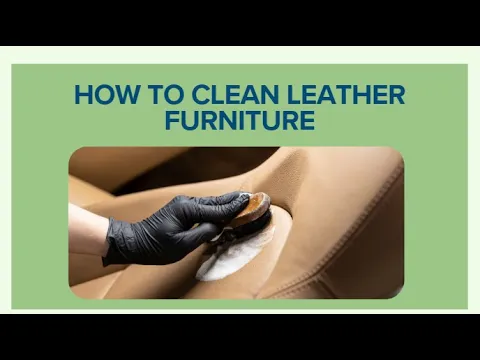
How to Clean Leather Furniture
Leather furniture is classy and sophisticated, immediately upgrading the appearance of any room. But, unlike upholstered furniture with fabric, leather needs special attention to preserve its texture, avoid cracks, and lengthen its lifespan. Without proper maintenance, it can lose its charm, becoming dull and worn out over time. If you want your leather furniture to remain a statement piece in your home, regular cleaning and conditioning are essential.
When preparing to move, expert bond cleaning Gold Coast is vital. It can assist in restoring your area, even your expensive leather furnishings. If you prefer a DIY approach, this blog will show you how to thoroughly clean leather furniture. Knowing the proper procedures and supplies will help you clean effectively while avoiding damage.
1. Knowing Your Leather Type Before Cleaning
Before you start cleaning, it is essential to identify what kind of leather you possess. Different leathers require different care methods, and using the wrong product can cause irreversible damage.
- Aniline Leather: It is soft and natural-looking but highly absorbent, making it prone to stains and water damage. It requires delicate care and specialised leather cleaners to maintain its texture and appearance.
- Semi-Aniline Leather: It has a light protective coating, which renders it more stain-resistant yet still has a luxurious feel. It can be cleaned with mild leather-safe solutions without damaging it.
- Pigmented Leather: It is the most common variety found in residential and business settings. Its tough coating repels stains and scratches, making it easier to clean and maintain over time.
Note- Before applying any cleaning solution, always do a patch test on a hidden area to check for any adverse reactions.
2. Regular Dusting and Vacuuming

Leather does not accumulate dust like other fabrics, but it still need frequent cleaning to keep it fresh. Dust and dirt settle in the folds and seams, that dulls the shine of the furniture over time. A microfibre cloth is best for wiping down surfaces on a weekly basis, as it cleans up dust well without scratching the leather. For more deep cleaning, a vacuum cleaner with a brush attachment can be used to clean out debris from areas that are hard to reach.
Avoid using rough cloths or paper towels a sit can cause damage to the surface. Also, avoid food crumbs and spills, as these can produce persistent stains if not cleaned in time. Pets are also potential culprits when it comes to leather, as the fur and dander of your pet can coat the leather so, regular cleaning is even more important to maintain hygiene and appearance.
3. DIY Leather Cleaning Solution
Professional cleaners are costly, but a DIY solution is as effective. Combine white vinegar and distilled water for a natural, effective cleaner for cleaning dirt and grime off of the leather. A few drops of gentle liquid soap will add to the cleaning ability without damaging the leather. To clean, dampen a microfiber cloth and wipe the furniture in circular motions. Don’t use too much of the solution as it may weaken the leather. After cleaning just wipe it down with a clean cloth and let the furniture air dry naturally.
Baby wipes are a convenient option for quick touch-ups. However, to avoid removing the leather’s protective layer, use alcohol-free wipes. If your furniture is old and delicate, using a professional leather cleaner offers further protection.
4. Tackling Stains the Right Way
Leather is susceptible to stains, and responding early is essential to preventing them from setting in. Ink stains, for example, can be cleaned using a cotton swab bathed in rubbing alcohol, followed by a clean towel to remove any residue. Grease stains can be removed with baking soda, which absorbs oil when left on the afflicted area for a few hours. Liquid spills should always be blotted immediately with a dry cloth to prevent the stain from spreading.
If the stains refuse to budge, professional bond cleaning Gold Coast services may be required. These personnel and their skills will guarantee that every stain is treated separately, improving the likelihood of a full bond return. When dealing with really deep stains, always use professional-grade leather cleaners.
5. Conditioning for Long-Term Protection
Leather, like skin, need moisture to remain soft and supple. Without regular conditioning, it might become dry and cracked. Applying leather conditioner every few months helps to replenish lost moisture, keeping the surface smooth and robust. A tiny amount should be applied with a microfibre cloth and gently massaged into the leather to ensure even absorption.
Allow it to sit for a few hours before using the furniture again to ensure that it has fully penetrated the material. Avoid oil- or silicon-based products, which can leave a greasy residue that attracts dirt.
To further protect your furniture, keep it away from direct sunlight, which can cause fading and drying. Using blinds or curtains can help maintain its colour and texture over time. A proper combination of conditioning and mindful placement ensures that your leather furniture stays in an excellent condition for years.
Tips to Clean Leather Furniture

Wrapping up
Cleaning and preserving leather furniture does not need to be difficult. With the proper approaches, you can keep its beauty and functionality for years. Regular dusting, light cleaning, and conditioning can help to ensure that your furniture lasts a long time in your home. Whether you choose professional help or a DIY approach, a little care goes a long way.

